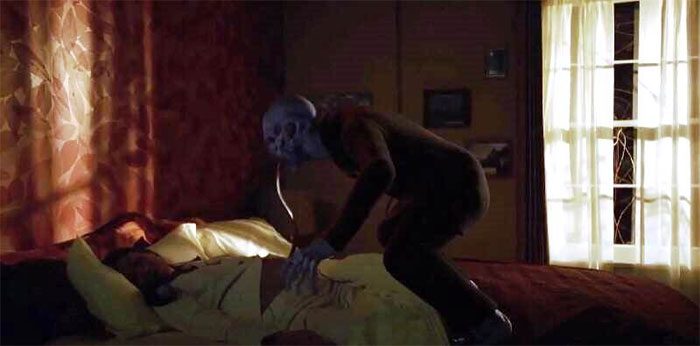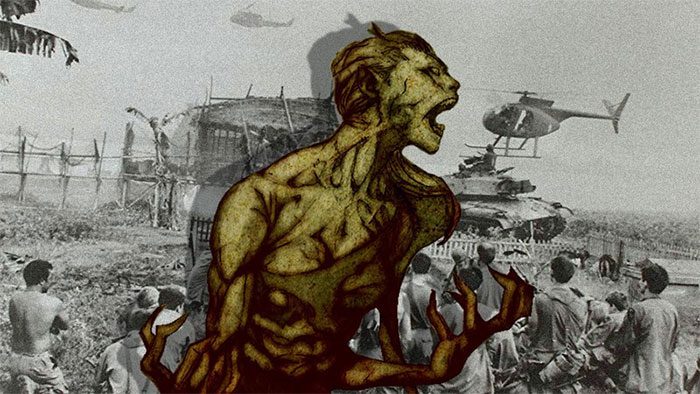Folklore passed down for centuries in the Philippines tells of the aswang, a creature that embodies the scariest traits of vampires, monsters, and witches.
As the most terrifying monster in all of Philippine mythology, the aswang can easily shapeshift between human and beast, attacking with incredible cruelty. Although legends of the aswang have existed for centuries, reports of sightings in the real world surged in the Visayas during the COVID-19 pandemic.

Scene of an aswang attacking a sleeping woman in a TV show. (Image: Netflix)
The Monster That Spreads Fear
The aswang is cunning, disguising itself as a human during the day. It blends into crowds, selecting victims to hunt at night. Resembling both a vampire and a witch, as well as a werewolf, ancient stories suggest that the most terrifying aspect of the aswang is its ability to walk right beside its victim without them knowing.
Furthermore, rumors that this monster preys on humans, primarily targeting children and fetuses through brutal attacks, have instilled fear in the hearts of Filipinos. It is said to lurk in dark corners, waiting to find its prey. The aswang often deceives its victims with sounds similar to a recurring “tick-tock”. As it gets closer, the “tick-tock” sound diminishes, tricking victims into believing the creature is moving further away, leading them to think they have escaped danger.
While the aswang can walk the streets during the day, it is at its weakest and unable to harm humans at that time. Locals often claim that they disguise themselves as women, sometimes described as beautiful with long black hair.
Characteristics to identify an aswang during the day include glowing red eyes and feet that are turned backward. They also dislike loud noises and bright lights. If one attempts to look into its eyes, their reflection will appear inverted. Another common way to detect an aswang is that boiling oil will bubble whenever it is near.
The Legends Behind the Monster
Stories about the aswang date back to the 16th century when Spanish soldiers first invaded the country and documented their encounters. However, some researchers suggest that these tales may originate from the 13th century when Malaysians arrived in the Philippines, bringing with them supernatural beliefs.

The aswang becomes a psychological weapon during wartime. (Illustration: Wikipedia).
Malaysian folklore also mentions a creature similar to the aswang known as the penanggal. These monsters disguise themselves as women during the day but reveal their long tongues and attack pregnant women at night.
In the records from the 16th century, the Spanish army described the aswang as the greatest fear of the local populace. However, it is also possible that they exaggerated the monster for their own purposes, associating them with the babaylan—female spiritual leaders in the Philippines—in an effort to promote Christianity in the region.
According to Esquire magazine, the Central Intelligence Agency (CIA) also exploited the local fears surrounding the aswang during the Cold War. Reports indicate that the CIA fabricated bodies resembling those drained of blood by monsters to demoralize the local population. Unsurprisingly, this plan proved effective.
Is the Aswang Real?
Based on the hypothesis that aswang are shapeshifting creatures, Filipinos believe that the animals transformed by aswang typically dwell on land. The distinctive sounds attributed to them are likely bird calls. Animals such as the Tasmanian devil (a carnivorous marsupial), bats, and flying lemurs have been killed en masse due to being mistaken for aswang in different forms.
Another explanation for the aswang is a rare genetic disorder known as XDP, which primarily affects Filipino men. This disorder causes uncontrollable trembling and muscle stiffness. Photos of those who have suffered from this condition closely resemble some descriptions of aswang. The original “homeland” of the aswang is rumored to be the Capiz region, which has the highest incidence of XDP cases.
Another possibility is that the aswang serves as a convenient excuse to conceal brutal murderers. Blaming a monster is often easier than admitting that a human is the true perpetrator of heinous acts. Tabloid newspapers have attributed murder crimes to the aswang to boost sales. The story of the aswang has also been used to explain cases of stillbirths and miscarriages in the Philippines.
Whether a fabrication of human intent or a terrifying creature, the aswang remains one of humanity’s darkest nightmares.


















































